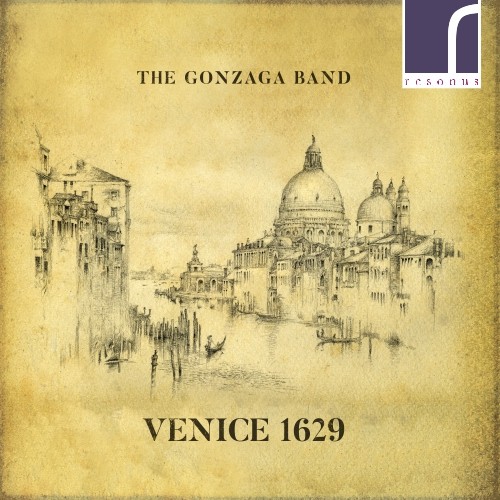 The Gonzaga Band, Venice 1629, Resonus Classics (LC28421), 2018.
The Gonzaga Band, Venice 1629, Resonus Classics (LC28421), 2018.
Jamie Savan, director, and cornett (treble cornett by John McCann, mute cornett by Serge Delmas, and tenor cornett by Christopher Monk); Helen Roberts, cornett by Paolo Faniciulacci; Faye Newton, soprano, Oliver Webber, violi; Theresa Caudle, violin, and cornett (by Roland Wilson); Steven Devine, organ and harpsichord
Recorded in St. Mary’s College Chapel, New Oscott, Sutton Coldfield, England at A=466 Hz, ¼ comma mean tone temperament
It is well-documented that Venice was a fertile place to be for musicians in the early 17th century. This recording focusses on a single year, 1629, which could arguably be thought of as a time of particularly high activity. It is of note that the plague reached Venice the following year. The highly detailed and very interesting program notes by Jamie Savan state that perhaps one-third of the population of Venice died from the plague in 1630-1631. He notes that there are 50 extant publications from Venice in 1629, 30 from 1630, and none from 1631. For that reason alone, a study and recording of music from 1629 is valuable.
On this recording, we find the music of several familiar composers: Claudio Monteverdi, Heinrich Schutz (who was making his second visit), Biagio Marini, and Dario Castello (about whose life we know so little as to suspect possibly that he was a pseudonym for a more well-known composer). We also find wonderful music from lesser-known composers: Martino Pesenti, Orazio Tarditi, Giovanni Carrone, and Benedetto Re.
The performances are uniformly excellent. Faye Newton sings with a light, warmly expressive voice and delivers technical passages with the grace and elegance of a ballerina. Jamie Savan displays great virtuosity in the demanding works of Castello. He is also very sensitive in his phrasing and blends beautifully with Newton on Congratulamini mihi of Carrone where he is playing the mute cornettt. He plays tenor cornett on Donati’s Maria Virgo. Listeners will also be pleased with the excellent cornett playing offered by Helen Roberts and Theresa Caudle. Of note, Caudle is also heard playing violin on several works. The final track, Castello’s Sonata decima settima offers brilliantly virtuosic playing by Savan which is impressively echoed by Roberts and Caudle.
In the notes, Jamie Savan mentions special efforts to tune the instruments as closely as possible using historical fingering patterns, citing recent research into original Venetian/Bassano cornets in the collection of the Acadamia Filarmonica. No further details are given. One hopes that in the future this will be expanded into some form of presentation to the early music community.
Venice 1629 is a delight on numerous levels. The performances are an excellent balance of graceful phrasing and virtuosity. The program is varied. As stated earlier, the works of several lesser-known composers are offered. There are six world premiere recordings on this disc. Finally, Jamie Savan prepared the performing editions of ten of the seventeen tracks. The recording represents a great deal of research, diligence, and creativity and deserves great attention for all performers or students of seventeenth century music.
-- James Miller



